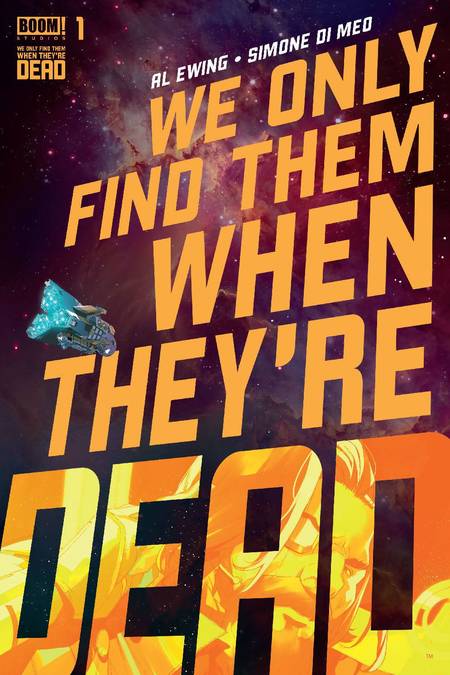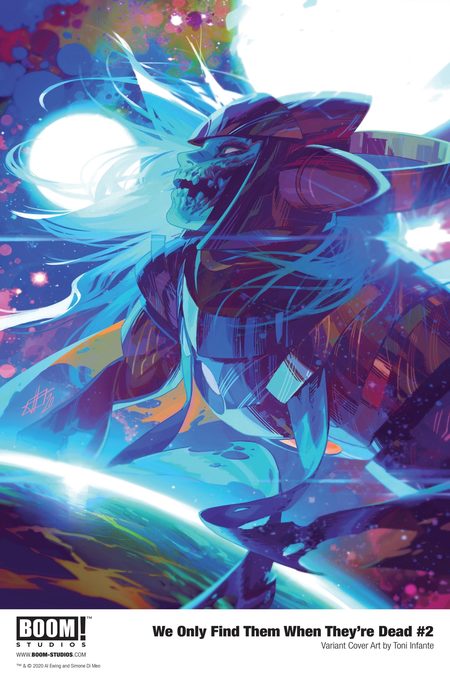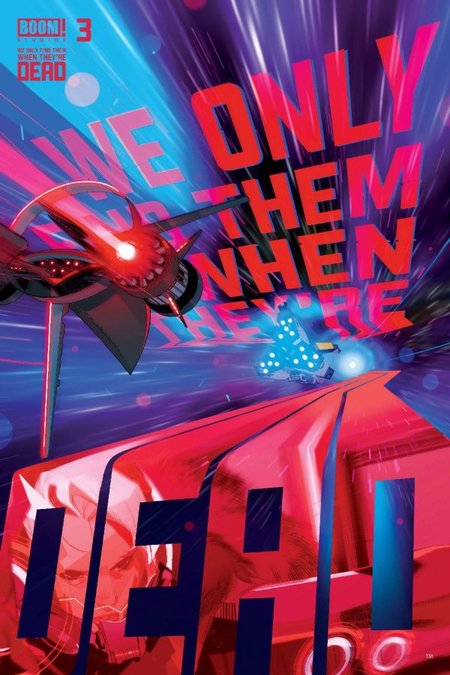The prospect of finding out the truth about something is powerfully and motivatingly intoxicating.
Operating as we so often do in a veil of lies and half-truths, much of it motivated by necessary social lubrication or the unwillingness of certain groups in society to gaze upon the authentic face of certain people or issues (our current age is a perfect example of this type of delusion), finding the out the truth, whatever the situation, awakens something profound within us.
At least, that is, those that clamour after the truth (there are, again, many who prefer fairytales or conspiracy-laced nonsense to the facts of any matter).
In We Only Find Them When They’re Dead, a vibrantly alive series from BOOM! Studios by writer Al Ewing (Immortal Hulk) and illustrations by Simone Di Meo (with colour assists by Mariasara Miotti and lettering by AndWorld Design, Captain Georges Malik, head of a crew of four on an autopsy ship in 2367, is determined to find out the truth behind the glowing god-like beings that are routinely found floating in the solar system he, along with many other people desperately clinging to life, inhabit.
With the asteroids all mined out, even in the outer regions of space, humanity survives by mining the corpses of the alien giants for meat and other biological and metallurgical products which are on-sold to a range of corporations, often for good money.
Theirs is a heavily-policed existence with an Officer on Duty always keeping watch for those that harvest where they have no permit to do so, their brand of justice often one that involves violent destruction rather than the natural course of law.
Malik is used to staying well within the letter of the law and taking only what he and his crew – Ella Hauer the Coroner, Alice Wirth the Quartermaster and Jason Hauer the Engineer – are permitted but the captain has never forgotten the thunderstruck sense of wonder he felt when he first saw a God, describing it this way:
“The first time you see a God is a moment you never forget. Their impossible scale. The sheer immensity of them. Their impossible beauty.
The Gods are always beautiful. And the Gods are always dead.” (issue 1: “Eight Bells, All’s Well”)
Malik may have never lost his reverence for the Gods but survival is survival and so like the crew of all the other autopsy ships, he takes what he has to, despoiling the extravagant if lifeless beauty of the Gods whom Di Meo brings, rather ironically, to vivid, arresting life with illustrations so vivacious and luminously colourful that you can’t help but feel the same staggering sense of awe that Maliks and many others do.
But two things trouble in the midst of the routine that is harvesting the Gods.
One, and this is of a more terrestrial nature, why is Paula Richter, the Officer on Duty much of the time, so hellbent of taking him down?
He knows her only as someone who has brought his family great trauma and pain but she seems to have a vendetta all her own, one he can’t fathom and which sees her pursue him into the void between systems where Malik has gone in the desperate hope that he can find a God alive and well.
His crew are somewhat supportive but also deeply wary, viewing his Moby Dick-like quest as both inspiring and unsettling all at once.
Malik, however, know he has to act on his instincts, come what may, and it’s his innate desire to find out the truth about the Gods that fills We Only Find Them When They’re Dead with a sense of impelling, vibrant humanity.
What makes this series so compelling to read though is how Ewing seamlessly melds the epic and the intimate, his storytelling laid out on a lavish solar system wide scale and yet its beating heart going right down to Malik, his love Jason Hauer and his crew, who support him even on what could generously be described as a fool’s errand.
But Malik wants more from life than what the authoritarian system of government allows him, and so he is willing to take all the risks in many worlds if it means he has a chance to really live in the same way he felt he did when he saw his first God in the company of his mother many decades earlier.
Di Meo, who touchingly pays tribute to her now-passed mother by saying she “taught me to look at the stars”, brings Ewing’s immensely intense and heartfelt tale to life with artwork that leaps off the page with an epic vivacity that makes you feel as if you are in each and every frame, living each moment with the fully-formed and entirely memorable characters.
There is a luminosity to the artwork that arrests you, helped clearly by Miotti’s gift for deftly using colour without once being garish, and draws you in with even the most intimate of moments feeling hugely, giddily alive.
We Only Find Them When They’re Dead is a joy to read because it never loses sight of the fact that even in the biggest and most sprawling of stories, there lies a human element that is what we most pay attention to and most clearly remember.
That humanity is evidenced in Malik, a man borne of great wonder and awe but also much tragedy and loss, and who is damned if he’s going to keep trudging along in life, one carefully-controlled foot in front of the other, when so much mystery and possibility awaits him.
The “glorious quest” of We Only Find Them When They’re Dead is thrilling and invigorating to read and alluring too with issue 5 ending on the mother of all “What ifs?”, with thankfully more issues in the offing to answer some very big questions all of which find them their form and answer, and most importantly, truth, in the form of one very eager and impelled man for whom the journey still has a long way to go …
leagueofcomicgeeks.com/comics/series/147604/we-only-find-them-when-theyre-dead


